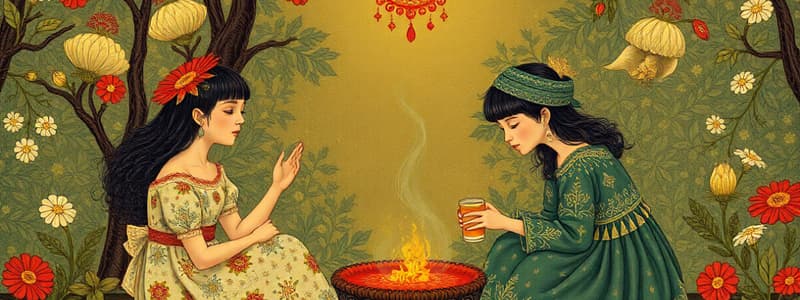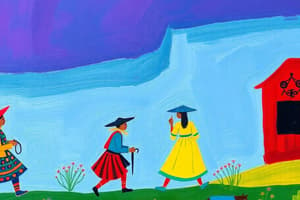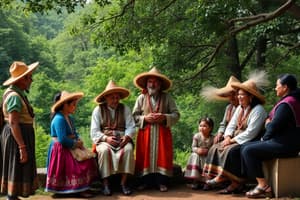Podcast
Questions and Answers
Which of the following is NOT one of the five qualities of true folklore as defined by JH Brunvand?
Which of the following is NOT one of the five qualities of true folklore as defined by JH Brunvand?
- It is traditional in form and transmission.
- Its authorship is often anonymous.
- Its content is often thematic and unique. (correct)
- It exists in different versions.
What does Alan Dundes’ definition of 'the folk' imply about the composition of folkloric groups?
What does Alan Dundes’ definition of 'the folk' imply about the composition of folkloric groups?
- Folkloric groups are limited to specific ethnic backgrounds.
- Folkloric groups can be defined by their geographical location.
- Folkloric groups may encompass any number of people sharing a common factor. (correct)
- Folkloric groups must have a historical origin.
Why is folklore considered a performance according to the content provided?
Why is folklore considered a performance according to the content provided?
- It strictly adheres to written scripts.
- It involves active participation and interaction among people. (correct)
- It is only shared in formal settings.
- It focuses solely on the material artifacts.
How does Dan Ben-Amos define folklore, and what aspect does it emphasize?
How does Dan Ben-Amos define folklore, and what aspect does it emphasize?
What distinguishes the Folk Process of Transmission from Mass Culture Transmission?
What distinguishes the Folk Process of Transmission from Mass Culture Transmission?
Which aspect contributes to the emotional connections associated with quilts, according to the content?
Which aspect contributes to the emotional connections associated with quilts, according to the content?
In the context of folklore, what is a significant characteristic of the interactions involved in its performance?
In the context of folklore, what is a significant characteristic of the interactions involved in its performance?
Which of the following best describes why quilts might be viewed simultaneously as cheap and cherished?
Which of the following best describes why quilts might be viewed simultaneously as cheap and cherished?
What distinguishes elite culture transmission from other forms of culture transmission?
What distinguishes elite culture transmission from other forms of culture transmission?
Which method of transmission is likely to result in fewer variants of a story?
Which method of transmission is likely to result in fewer variants of a story?
According to McNeill, what does the term 'traditional' imply in folklore studies?
According to McNeill, what does the term 'traditional' imply in folklore studies?
How does McNeill define folklore?
How does McNeill define folklore?
Why is writing considered a technology?
Why is writing considered a technology?
Approximately how old is the technology of writing?
Approximately how old is the technology of writing?
Which of the following is NOT a characteristic of writing compared to orality?
Which of the following is NOT a characteristic of writing compared to orality?
Which characteristic does NOT describe informal culture transmission?
Which characteristic does NOT describe informal culture transmission?
What structural feature is characteristic of proverbs?
What structural feature is characteristic of proverbs?
Which of the following best defines the purpose of a proverb?
Which of the following best defines the purpose of a proverb?
At what age do children typically begin to produce short phrases according to stages of language acquisition?
At what age do children typically begin to produce short phrases according to stages of language acquisition?
What common theme can be found in proverbs regarding their content?
What common theme can be found in proverbs regarding their content?
Which statement about languages is TRUE?
Which statement about languages is TRUE?
At what developmental stage do children typically start to babble?
At what developmental stage do children typically start to babble?
Which of the following statements about folklorists is accurate?
Which of the following statements about folklorists is accurate?
What age do children typically achieve full grammar and linguistic capabilities?
What age do children typically achieve full grammar and linguistic capabilities?
What was the primary purpose of William Thoms coining the term 'folk-lore'?
What was the primary purpose of William Thoms coining the term 'folk-lore'?
Which of the following is an example of folklore as described in the content?
Which of the following is an example of folklore as described in the content?
What do Dorothy Noyes and Henry Glassie suggest about the nature of folklore?
What do Dorothy Noyes and Henry Glassie suggest about the nature of folklore?
According to the content, how does folklore remain relevant in contemporary life?
According to the content, how does folklore remain relevant in contemporary life?
Which of the following statements is true about the significance of folklore?
Which of the following statements is true about the significance of folklore?
In what way can quilts serve as an example of folklore?
In what way can quilts serve as an example of folklore?
What misconception about folklore is clarified in the content?
What misconception about folklore is clarified in the content?
Which phrase describes the dualities discussed in the definitions of folklore?
Which phrase describes the dualities discussed in the definitions of folklore?
What is the folkloristic definition of superstition?
What is the folkloristic definition of superstition?
Which of the following best describes a magical action?
Which of the following best describes a magical action?
How does traditionalization validate superstitions?
How does traditionalization validate superstitions?
What role do superstitions play in complex human situations?
What role do superstitions play in complex human situations?
What does the concept of conversion in superstitions refer to?
What does the concept of conversion in superstitions refer to?
In what way can rationalism and superstitious thinking coexist?
In what way can rationalism and superstitious thinking coexist?
What does the story of the Fox and the Crow illustrate in relation to superstition?
What does the story of the Fox and the Crow illustrate in relation to superstition?
What is a superstitious sign?
What is a superstitious sign?
Flashcards are hidden until you start studying
Study Notes
Folklore in Daily Life
- Common expressions and childhood games illustrate the prevalence of folklore in everyday activities.
- Folk wisdom examples include phrases like "You can’t teach an old dog new tricks" and "Never judge a book by its cover."
- Games such as "Rock, Paper, Scissors" highlight informal cultural knowledge passed through interactions.
Folklore's Relevance
- Folklore is not a fading phenomenon; it evolves and adapts to current language and society.
- It maintains significance in cultural identity, reflecting ongoing human experiences despite societal changes.
Importance of Folklore
- Folklore transcends triviality; it embodies vital cultural values and shared knowledge.
- It shapes cultural identity, revealing beliefs, traditions, and experiences within communities.
Coinage of "Folk-Lore"
- William Thoms introduced the term "folk-lore" in 1846, emphasizing knowledge of the people, reflecting culture and experiences.
Dual Nature of Folklore
- Dorothy Noyes notes the tension between repudiation (seen as outdated) and nostalgia (valued for its cultural beauty).
- Henry Glassie contrasts tradition (continuity) with variation (change), further defining folklore's complexity.
Quilting as a Cultural Artifact
- Quilts exemplify folklore's duality as they may be perceived as old-fashioned yet celebrated for craftsmanship and nostalgia.
Characteristics of "True Folklore"
- JH Brunvand identifies five qualities: verbal, customary, or material content, traditional form, multiple versions, anonymous authorship, and formularization.
Defining "the Folk"
- Alan Dundes defines "the folk" as any group sharing a common factor, ranging from families to nations based on traditions and practices.
Folklore as Performance
- Folklore is a performance involving active participation and interaction, emphasizing how elements are shared and enacted in a community.
Dan Ben-Amos on Folklore
- Dan Ben-Amos describes folklore as "artistic communication in small groups," underscoring its interactive and creative nature.
Models of Transmission
- Folk Process of Transmission: Folklore changes as it is shared through informal channels, akin to the game "telephone."
- Mass Culture Transmission: Uniform transmission from a single source to many, causing no variations.
- Elite Culture Transmission: Selective sharing leads to varied interpretations of the same piece of information.
Impact of Transmission Methods
- Different methods (e.g., email vs. word-of-mouth) affect how folklore is altered as stories are shared, showing variability in retellings.
McNeill’s Perspective on Tradition
- McNeill argues "traditional" means "passed on," regardless of age, allowing new creations to be considered traditional if they are shared.
Definition of Folklore
- McNeill defines folklore as "informal, traditional culture," emphasizing its evolution outside formal institutions through personal sharing.
Writing as a Technology
- Writing is an invented communication tool enabling the storage and transfer of information over time and space.
Age of Writing Technology
- Writing technology dates back about 5,000 years, beginning with Sumerian cuneiform around 3,200 BCE.
Differences Between Orality and Literacy
- Various linguistic skills develop at different ages, shaping the way children communicate and engage with language.
Folklore and Ethnography of Speaking
- The fable "Fox & the Crow" illustrates how folklore anthropomorphizes characters to convey human-like themes and lessons.
Folkloristic vs. Scientific Definition of Superstition
- Folkloristic: Superstitions are beliefs around chance and magic based on perception of cause and effect.
- Scientific: A standard unscientific belief often seen as without foundation.
Components of Superstitions
- Signs represent omens (e.g., "Are your ears burning?").
- Magical actions depend on specific conditions (e.g., carrying an umbrella to prevent rain).
- Conversion merges signs into magical actions (e.g., wishing upon a shooting star).
Complexity of Superstitions
- Superstitions address unpredictable human experiences related to luck, love, and happiness, providing coping mechanisms.
Traditionalization and Validation of Superstitions
- Superstitions gain legitimacy through repeated cultural practice, such as beliefs in lucky charms or healing properties.
Rationalism and Superstitious Thinking
- Rationalism and superstition can coexist, exemplified by dowsing as both a folkloric tradition and a practical method for finding water.
Studying That Suits You
Use AI to generate personalized quizzes and flashcards to suit your learning preferences.




